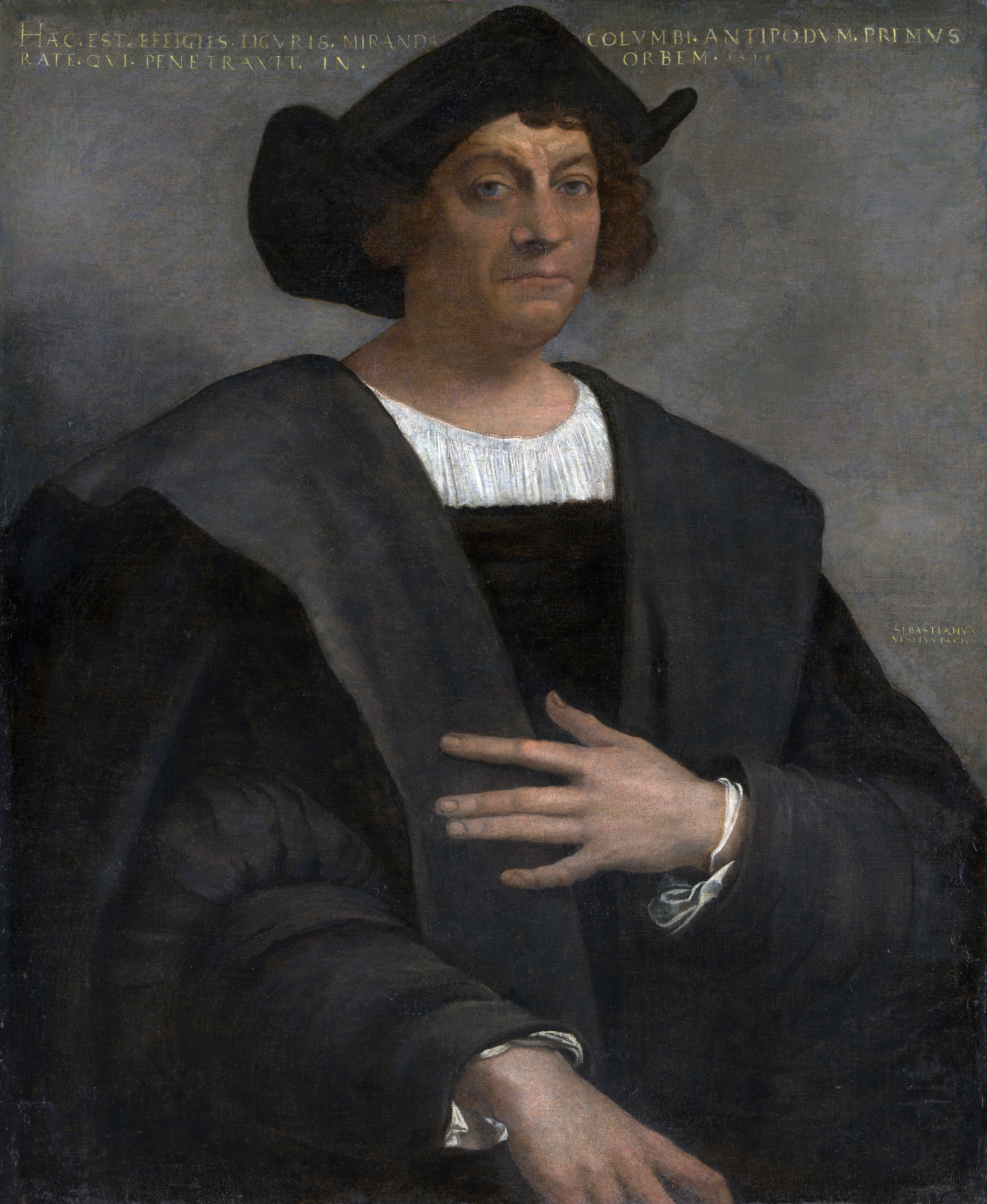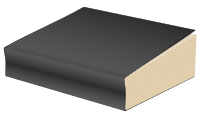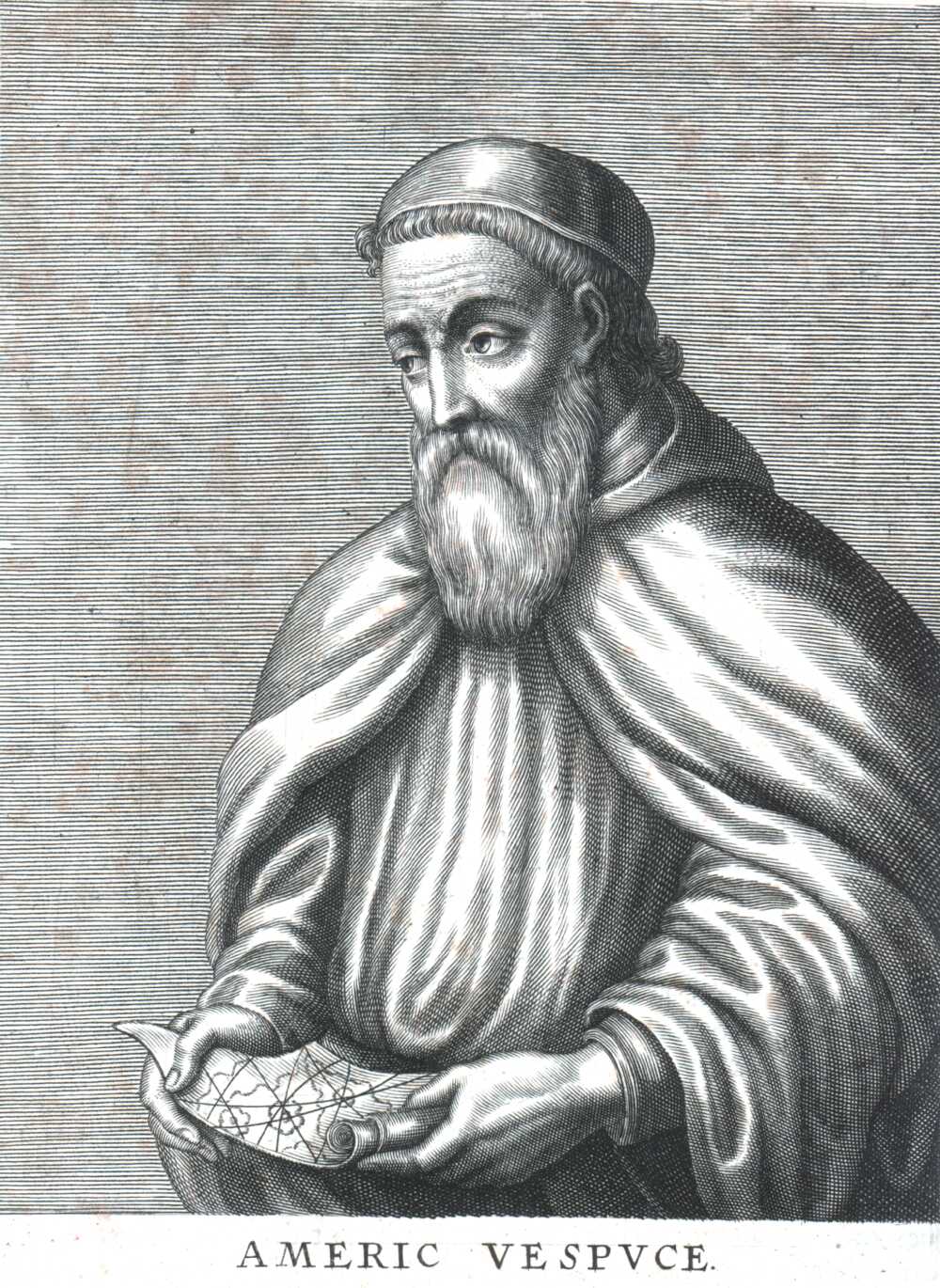World Map, 1691

Topics on the Page
Exploration and Trade
Major European Explorers
- Vasco Nuñez de Balboa
- John and Sebastian Cabot
- Jacques Cartier
- Samuel de Champlain
- Christopher Columbus
- Henry Hudson
- Ferdinand Magellan
- Juan Sebastian Elcano
- Enrique of Malacca
- Juan Ponce de Leon
- Amerigo Vespucci
- Vasco da Gama
 Cross-Link to Viking Exploration of North America
Cross-Link to Viking Exploration of North America
Focus Question: What did each explorer seek on his journey, what did he find, and how did his encounters with native peoples change global interactions at the time?
Exploration and Trade
Go here for a list of major European explorers of Africa, the Caribbean, South America and North America from a 3 Minute Animated YouTube Video.
Explorer Timeline for an interactive timeline which you can press on picture to get more information.
 Primary Source Set, Explorers Part 2, Library of Congress Teaching with Primary Source at Quincy University
Primary Source Set, Explorers Part 2, Library of Congress Teaching with Primary Source at Quincy University
For a group project assignment for students to research different explorers with additional links for each explorer, see WebQuest
See also Early Encounters Between Native Americans and Europeans from Gilder Lehrman Institute of American History
Navigation of the American Explorers: 15th to 17th Centuries from the Penobscot Marine Museum.
https://www.youtube.com/watch?v=njVWQooKE4E -- Brief overview of European Explorers and the Indigenous people who occupied the existing land.
Native People's Concept of Health and Illness
- Effects European Explorers had on native tribes and cultures and diseases that were brought to their land.
- Timeline of the negative effects the European Explorers had on native tribes and culture. This timeline includes the introduction to new diseases, losing land to colonizers, and the poor treatment the native people endured including kidnapping and physical abuse.
 Click here for a lesson plan about the Age of Encounter, which was led by navigators including: Christopher Columbus, John Cabot, Vasco de Gama, Amerigo Vespucci, Ferdinand Magellan, and Francis Drake.
Click here for a lesson plan about the Age of Encounter, which was led by navigators including: Christopher Columbus, John Cabot, Vasco de Gama, Amerigo Vespucci, Ferdinand Magellan, and Francis Drake.
.png) Click here for a Crash Course video about the Age of Exploration.
Click here for a Crash Course video about the Age of Exploration.

Vasco Nuñez de Balboa
- What He Wanted. Balboa was went on an expedition with Roderigo de Bastidas looking for treasure for Spain. The explorers were allowed to keep four-fifths of the treasure, while the monarchs got 1/5. This was called the Quinto Real, or Royal Fifth.
- What He Found. After settling on the island of Hispaniola for a time, but had to leave to escape his creditors. After a journey stowing away on a ship, he ended up at Darien, on the west coast of the Gulf of Mexico. He then helped to found Santa Maria, eventually becoming its mayor. He went on to discover the South Sea, taking possession of it and the many riches of gold and pearls he found there.
- Lasting Influence Balboa is one of the main reasons Spain had control of Mexico and Hispaniola. This affected the cultures and languages of the people, and Spanish is still spoken there today.
Balboa Taking Possession of the Pacific Ocean
- What He Wanted. John Cabot wanted to be part of the imperial movement that was sweeping Europe. Although he knew that Columbus had not been successful at finding Asia, he thought that he would be if he sailed a more northerly route. He also wanted to find Asia to trade goods, but he also wanted to spread Christianity.
- What He Found. Cabot landed on the east coast of what is now Canada in 1497. While Cabot didn’t find people right away, he did see signs of people and thought that they, along with their wealth, must be somewhere near by. But instead one of Cabot’s biggest discoveries was fish. So many fish he couldn’t believe it. The ocean had been overfished in Europe, so news of the abundance of fish in the “New World” made many Europeans to look to Newfoundland for livelihood.
- Lasting Influence. Cabot influenced the early fishing communities of Newfoundland, but he did not go down in history as one of the most influential explorers. Perhaps this is because his actions did not lead to a major change in the world economy or a major subjugation of people.
John Cabot"s Voyage to America (1497)
-
What He Found. Cartier was disappointed when he arrived because he was not met by his image of what a wealthy land would be. But eventually he became interested in meeting local people and having them show him the area. By exploring rivers, he was able to go inland and learn about the natural resources along river banks.
Jacques Cartier Claims Land for France
 |
| Samuel de Champlain |
- What He Wanted: He was an explorer who was interested in learning about the new lands of North America.
- What He Found: The founder of the city of Quebec and the first European to discover the Lake Champlain. He explored territory as far south as the Massachusetts Bay, mapping areas that English explorers, who would land there in 1607, hadn't yet touched.
- Lasting Influence: He was the first European to explore the Great Lakes and now considered to be the founder of New France.
Champlain's interaction with the Iroquois (1609)
Christopher Columbus
See also Columbus, Magellan, Ponce de Leon and Vespucci
 |
| Christopher Columbus |
- What He Wanted: Christopher Columbus a good navigator and sailor, and made several trips to the Americas in his lifetime 1 . He was obsessed with gold and wealth. He wanted to do anything possible to obtain wealth. At the time, forcing people into slavery to help you get rich was a popular idea in Europe, and Columbus did not see a problem with this. In 1492, he was financed by Ferdinand and Isabella of Spain to sail across the ocean in search of gold in Asia. Ferdinand and Isabella wanted Columbus to bring back gold so that they could compete with Portugal, who was becoming wealthy by colonizing Africa.
- What He Found: Columbus sailed west thinking that eventually he would get to Asia. He calculated that Asia was only 3,000 miles away, even though others told him it was probably more like 12,000 miles away. After 3,000 miles of traveling across the Atlantic, he landed in the Caribbean, although he thought it was Asia. He landed in the Bahamas and later explored the island of Hispaniola and other islands. He was fascinated by the Taino people who lived there, but he did not respect them. He forced them to work to find gold. If the didn’t find the right amount of gold, he or his men often killed them. Their lives were destroyed. Columbus also captured many to take back to Europe.
- Lasting Influence: Although Columbus never found out that the land he had reached wasn’t Asia, others who came after him knew it. In other words, others learned from his mistakes. Columbus opened Europe’s eyes to the Americas. Because Columbus’ expeditions resulted in the first mass meeting of Europeans with people of the Americas, and because Columbus was racist and disrespectful to them, he helped to set a standard for how Europeans would think about Tainos and other native people. His legacy for the people’s of the Americas was enormous and devastating. Although he caused so much destruction, he is often remembered as a hero, and we even have a federal holiday in his honor. Why do you think this is?
Lesson Plan -- What Was Columbus Thinking?
https://americanindian.si.edu/nk360/about/understandings#eublock1 -- Lessons and Resources from the National Museum of the American Indian for Indigenous People's Day.
The Reality and Myth of Christopher Columbus -- a stack of information on the intentions of Columbus.
See National Geographic Video video giving explanation on Columbus
https://kids.britannica.com/students/article/early-exploration-of-the-Americas/543490/media?assemblyId=1071 -- Interactive map of the voyages Columbus endured.
Colombian Exchange Sporcle quiz/game
http://www.sporcle.com/games/lupin/columbian_exchange
 Check out Charles C Mann's Book 1491 http://www.amazon.com/1491-Revelations-Americas-Before-Columbus/dp/1400032059
Check out Charles C Mann's Book 1491 http://www.amazon.com/1491-Revelations-Americas-Before-Columbus/dp/1400032059
Henry Hudson
 |
| Henry Hudson |
Hudson went on four expeditions from Europe to North America between in the early 1600s. In 1602, a Dutch United East India Company led by Hudson wanted to find a passage to India. Instead, like many others, they landed in North America.
Instead of finding gold and spices, Hudson found a beautiful river, with fertile land and lots otter and beaver. He and his expedition traveled up the river all the way to present day Albany. The river became known as the Hudson River. Although they never found a passage to the Indies, they were satisfied that they had found a place that could live and prosper. Because it was cold in Europe, and because Europe was more populated and therefore had fewer wild animals, setting up fur trade with the local people seemed like the perfect plan.
Henry Hudson helped to establish a large Dutch settlement in what is now New York. This led to the Dutch purchasing the island of Manhattan. Manhattan became an important site of trade and economy for Europeans in North America.
Native American Response to Henry Hudson (C-Span with Evan Haefeli on November 5, 2009)
This is a long video but sections of it could be used.
Short Biography of the life of Henry Hudson - Explorer and Navigator : quick facts about Hudson.
Explorations of Henry Hudson
See also Columbus, Magellan, Ponce de Leon and Vespucci
Magellan a Portuguese-born navigator enlisted the king of Spain's support for an expedition to reach the Moluccas (islands in Indonesia) by sailing westwards. The trail eastwards was controlled by Portugal and Magellan had had a disagreement with the Portuguese king. The Spanish wanted a share in the valuable spice trade from the Moluccas.
Magellan set out on September 1519 with a fleet of five vessels. In spite of a mutinous crew, rough weather, scurvy, a desperate lack of provisions and unknown waters, Magellan managed to cross the Atlantic and navigate through the straits at the southern point of South America which were later named after him.
Now with only three ships, Magellan sailed on into the Pacific with rapidly diminishing supplies, which led to many of the crew dying of starvation and scurvy. After around 14 weeks they reached an island, probably Guam, in the western Pacific. They then sailed on to the Philippines. On 27 April 1521, Magellan was killed there after becoming involved in a battle between two rival local chieftains.
The Strait of Magellan, at the Southern point of South America, is named after him. His crew reached spain in September 1522, completing the first ever circumnavigation of the globe.
The Biography of Juan Sebastian Elcano
- He completed the around the world navigation after Magellan's death
Statue of Panglima Awang (Henrique of Malacca)

See The Slave You Circumnavigated the World that discusses Enrique of Malacca, Magellan's slave who became the first to sail around the world in one direction.
- "Enrique was born in the Philippines, sailed west to Europe, and continued west with Magellan 10 years later to return to the place of his birth" (The Writers' Almanac, October 2, 2104).
How the Natives of the Philippians defeated Magellan
http://www.eyewitnesstohistory.com/magellan.htm
A video depicting Magellan's Voyage (1519 -1522)
Juan Ponce de Leon
See also Columbus, Magellan, Ponce de Leon and Vespucci
Ponce de Leon was searching for the legendary Fountain of Youth and other riches exclusive to the New World
Was there really a fountain of youth?
https://www.youtube.com/watch?v=1bBND17RAvw
Juan Ponce de Leon was given the right by the King of Spain to find and conquer the island of Bimini in the Bahamas. After stopping at several islands, including Grand Turk Island and San Salvador, Ponce de Leon arrived to the east coast of Florida, which he named "Pascua de Florida" or "Feast of Flowers". On his way back to Spain, he discovered a warm current in the Atlantic known as the Gulf Stream. He later would establish Spanish settlement in Puerto Rico, whose influence in the New World allowed Spain to gain more power.
Ponce de Leon was the first European to set foot in Florida. He also is recognized as establishing the oldest European settlement in Puerto Rico and discovering the Gulf Stream, a current which became extremely helpful for European explorers traveling to the Americas.
Amerigo Vespucci

See also Columbus, Magellan, Ponce de Leon and Vespucci
- What He Wanted. Vespucci had been asked to observe Pedro Alvarez Cabral on one of his expeditions. During this time, Brazil was discovered and King Manuel I of Portugal wanted to know if it was an island or a larger land mass. Because of his experience, he sent Amerigo Vespucci as a leader.
- What He Found Amerigo Vespucci found that South America extended much farther south than had previously been believed.
- Lasting Influence The name "America"- Martin Waldseemuller published a map on which he called the landmasses of the New World "America". He came up with the name by feminizing and Latinizing "Amerigo".
- What He Wanted. da Gama sailed in 1497 seeking both fortune (in the trade of spices from Asia) and religious dominance of Christainity over Islam. He hoped, in part, to find Christians in India who would rise up against Muslims.
- What He Found. He made three extraordinary voyages, sailing south and then north around Africa and then across the Indian Ocean.
- Lasting Influence. His voyages established Portugal, a tiny country, as a world power, opening trade routes and establishing European in the Indian Ocean world.
Additional Information on da Gama's voyage and colonization http://www.sahistory.org.za/topic/vasco-da-gamas-voyage-discovery-1497
 For more, see Holy War: How Vasco da Gama's Epic Voyages Turned the Tide in a Centuries-Old Clash of Civilizations. Nigel Cliff. HarperCollins, 2011.
For more, see Holy War: How Vasco da Gama's Epic Voyages Turned the Tide in a Centuries-Old Clash of Civilizations. Nigel Cliff. HarperCollins, 2011.
Links
http://www.columbusnavigation.com (Christopher Columbus Navigation)
http://www.heritage.nf.ca/exploration/cabot.html (John Cabot)
http://www.civilization.ca/vmnf/Explor/carti_e1.html (Jacques Cartier)
http://history-world.org/dutch_settlement.htm (Henry Hudson)
Sources
Norton, et al, Mary Beth (1994). A People and a Nation. Boston: Houghton Mifflin Company.
Zinn, Howard (2003). A People’s History of the United States.New York: Perennial Classics.
(1997). John Cabot. Retrieved April 12, 2007, from Newfoundland and Labrador Heritage Web site: http://www.heritage.nf.ca/exploration/cabot.html
(2007). John Cabot. Retrieved April 13, 2007, from Britannica Web site: http://www.britannica.com/eb/article-9018457/John-Cabot
University of Toronto, (2000). Cartier, Jaques. Retrieved April 13, 2007, from Dictionary of Canadian Biography Online Web site: http://www.biographi.ca/EN/ShowBio.asp?BioId=34229
The Mariners Museum, (Date Unknown). Age of Exploration, Henry Hudson. Retrieved April 13, 2007, from The Mariner's Museum Web site: http://www.mariner.org/educationalad/ageofex/hudson.php
Valentine, David T. (Copyright 1995-2006, Updated January, 2007). Dutch Settlement Of New York. Retrieved April 1, 2007, from International World History Project Web site: http://history-world.org/dutch_settlement.htm
Image IDs from left to right
1. John Cabot Wikimedia Commons, "John-cabot".
2. Jacques Cartier Wikimedia Commons, "Cartier".
3. Christopher Columbus Wikimedia Commons, "CristobalColon".
4. Henry Hudson Wikimedia Commons, "Hudson-shaw".
Comments (0)
You don't have permission to comment on this page.